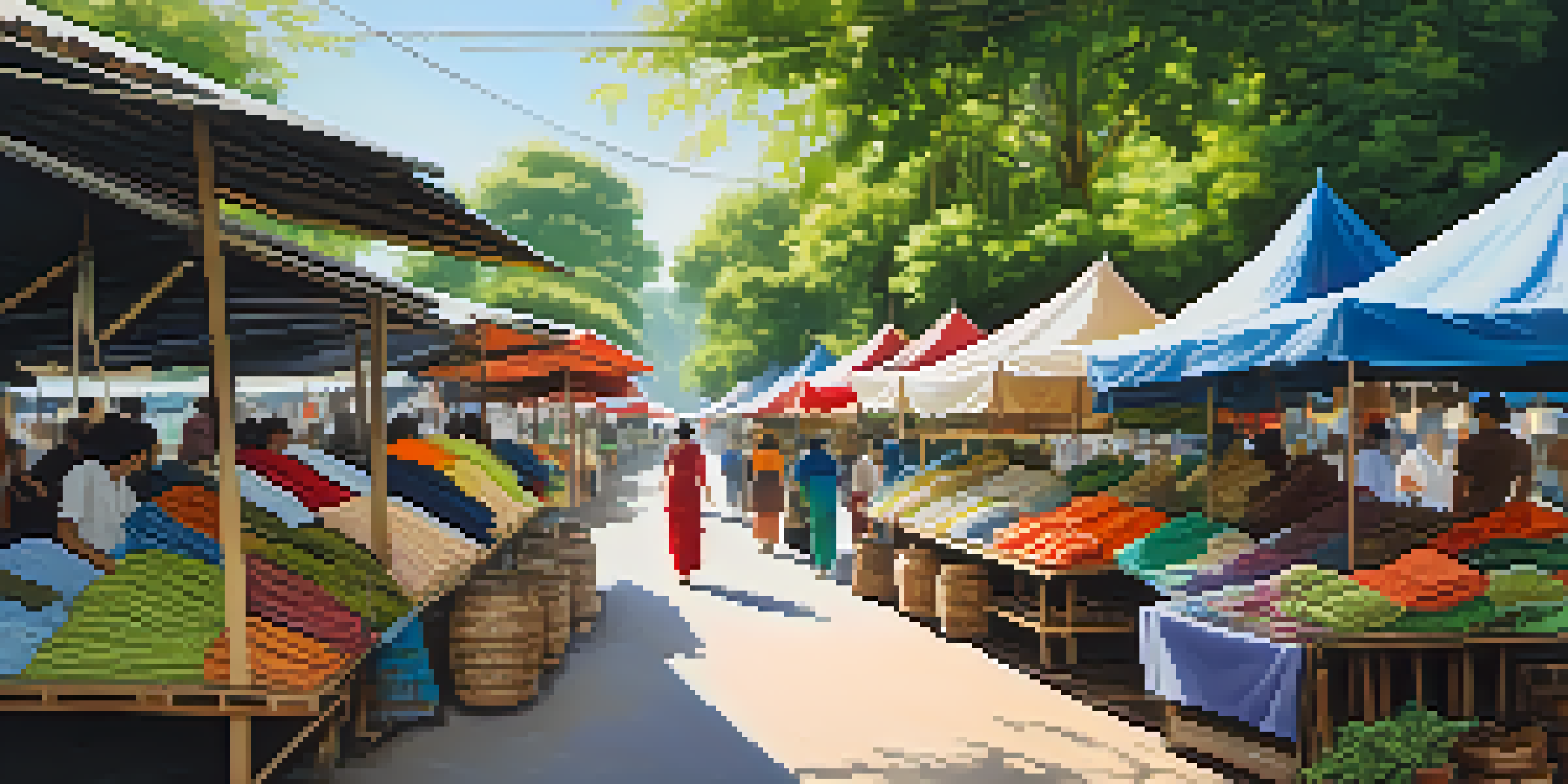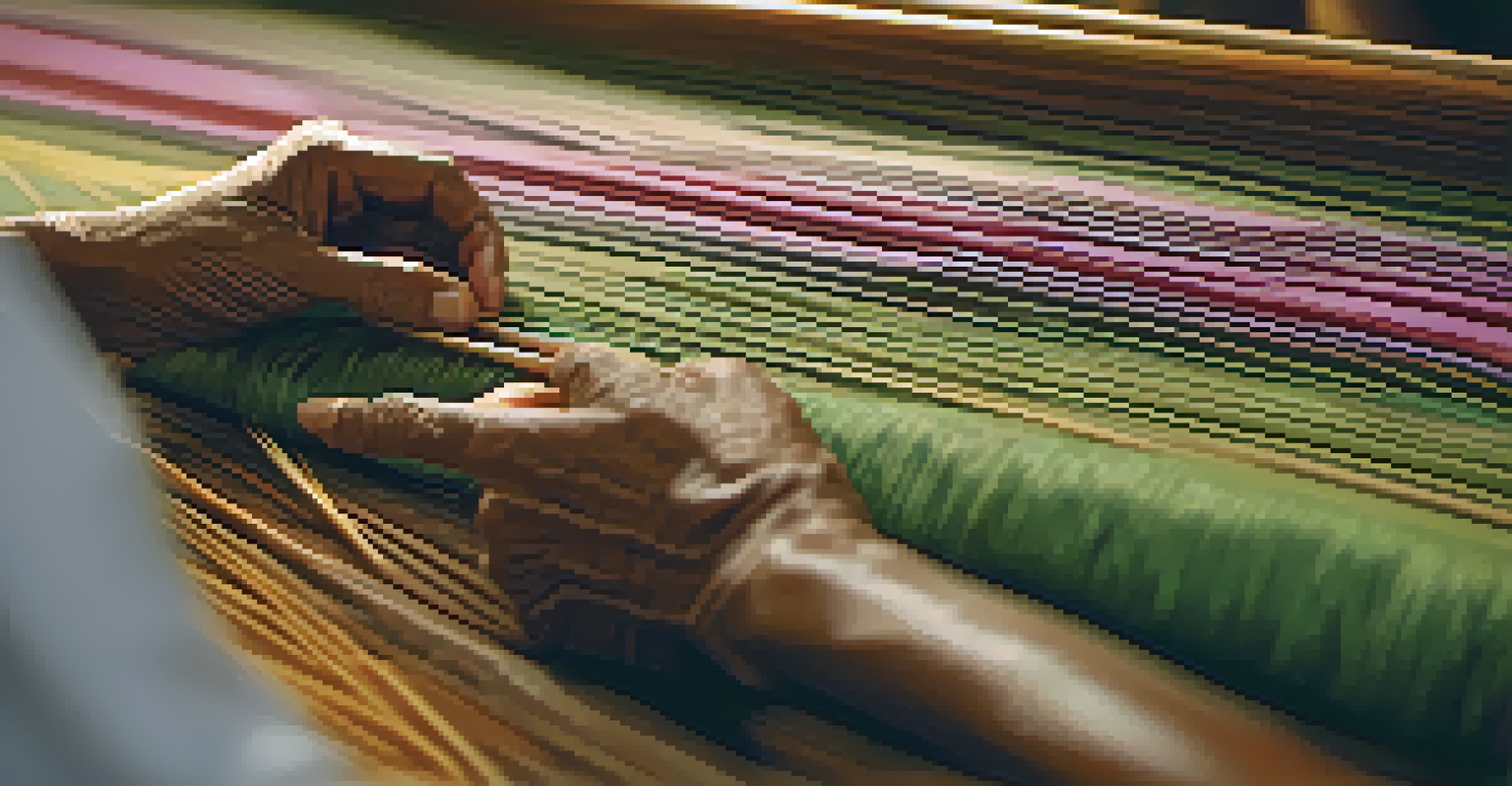Eco-Friendly Fabrics: A Key Component of Thai Sustainable Fashion

Understanding Eco-Friendly Fabrics in Sustainable Fashion
Eco-friendly fabrics are textiles made from natural, renewable resources that minimize environmental impact. In Thailand, these fabrics play a crucial role in promoting sustainable fashion, which aims to reduce waste and pollution while supporting ethical production. By choosing materials that are biodegradable or sourced from sustainable practices, designers can create beautiful garments that align with eco-conscious values.
Sustainability is no longer about doing less harm. It's about doing more good.
These fabrics can include organic cotton, bamboo, and hemp, each offering unique benefits. For instance, organic cotton is grown without harmful pesticides, making it a healthier option for both the planet and the people who wear it. In contrast, bamboo is known for its rapid growth and minimal resource use, making it an excellent alternative to traditional textiles.
The rise in popularity of eco-friendly fabrics reflects a growing awareness among consumers about the environmental footprint of their clothing. As Thai fashion designers embrace these materials, they're not just changing the fabric of their garments; they're changing the narrative around fashion itself, promoting a more sustainable and responsible approach.
The Role of Traditional Thai Textiles in Sustainability
Thailand boasts a rich heritage of traditional textiles, such as silk and cotton, which can be produced sustainably. For centuries, local artisans have employed techniques that emphasize quality and craftsmanship over mass production. This traditional approach not only preserves cultural heritage but also aligns with modern sustainability goals.

Using traditional methods can reduce the environmental impact associated with industrial textile production. Handwoven fabrics, for example, require less energy and generate less waste compared to machine-made alternatives. By revitalizing these age-old techniques, Thai designers are ensuring that their work is both environmentally friendly and culturally significant.
Eco-Friendly Fabrics Drive Change
Eco-friendly fabrics made from sustainable materials are reshaping the fashion industry in Thailand, promoting ethical production and reducing environmental impact.
Moreover, promoting these traditional textiles allows small communities to thrive economically. As demand for sustainable fashion grows, so does the opportunity for artisans to showcase their skills and craftsmanship, creating a win-win situation for both the environment and local economies.
Innovative Practices in Thai Sustainable Fashion
Thai designers are increasingly adopting innovative practices to enhance sustainability, such as upcycling and zero-waste design. Upcycling involves transforming discarded materials into new clothing, giving them a second life and reducing waste. This creative approach not only addresses environmental concerns but also encourages a sense of resourcefulness.
The greatest threat to our planet is the belief that someone else will save it.
Zero-waste design takes this a step further by aiming to create garments without any leftover fabric during the cutting process. Designers meticulously plan patterns to ensure every scrap is used, which significantly minimizes waste. This practice challenges the traditional notions of fashion production and encourages a more thoughtful approach to garment creation.
By integrating these innovative practices, Thai fashion is setting trends that prioritize sustainability while also inspiring creativity. This shift not only benefits the environment but also positions Thai designers as leaders in the global movement towards more responsible fashion.
The Impact of Consumer Choices on Sustainable Fashion
Consumer choices play a significant role in the success of sustainable fashion. As shoppers become more aware of the environmental impact of their purchases, they increasingly seek out eco-friendly options. This shift in consumer behavior empowers designers and brands to prioritize sustainability in their collections.
When consumers choose to support brands that use eco-friendly fabrics, they help to create a demand-driven market for sustainable fashion. This, in turn, encourages more designers to explore sustainable practices, creating a positive feedback loop that benefits both the environment and the fashion industry.
Traditional Textiles Support Sustainability
Traditional Thai textiles, produced through artisanal methods, not only preserve cultural heritage but also align with modern sustainability goals.
Moreover, informed consumers often share their experiences and knowledge, further promoting awareness around sustainable fashion. By fostering a community that values eco-conscious choices, consumers can drive significant change within the industry, making sustainable fashion more mainstream.
Government Initiatives Supporting Sustainable Fashion in Thailand
The Thai government has recognized the importance of sustainable fashion and is taking steps to support the industry. Initiatives aimed at promoting eco-friendly practices include grants for research and development in sustainable textiles and incentives for businesses that prioritize environmentally friendly operations. These efforts help to create a more robust framework for sustainable fashion in the country.
By fostering collaboration between designers, manufacturers, and policymakers, the government is working to create an ecosystem where sustainable fashion can thrive. Such collaborations can lead to innovations in materials and production techniques that further reduce environmental impact.
As these initiatives gain momentum, they pave the way for Thailand to become a leader in sustainable fashion, attracting attention from global markets. This not only enhances the country’s reputation but also supports local economies by creating jobs in sustainable industries.
Challenges Facing Eco-Friendly Fabric Adoption
While the movement towards eco-friendly fabrics is promising, several challenges hinder its widespread adoption. One major issue is the higher cost of sustainable materials compared to conventional fabrics. This price difference can be a barrier for both designers and consumers, who may prioritize affordability over sustainability.
Additionally, the availability of high-quality eco-friendly fabrics can be limited, making it difficult for designers to source materials that meet their aesthetic and ethical standards. As demand grows, suppliers need to scale up production while maintaining sustainable practices, a task that requires time and investment.
Consumer Choices Influence Fashion Trends
As consumers increasingly prioritize eco-friendly options, their choices empower designers to adopt sustainable practices, driving the fashion industry toward greater responsibility.
Despite these challenges, the commitment to sustainability is strong. Many designers are finding innovative solutions to these obstacles, such as partnering with local producers or investing in new technologies to create sustainable fabrics. This resilience reflects the growing determination within the fashion industry to embrace eco-friendly practices.
The Future of Eco-Friendly Fabrics in Thai Fashion
The future of eco-friendly fabrics in Thai fashion looks bright, driven by innovation and a commitment to sustainability. As more designers incorporate these materials into their collections, the landscape of fashion in Thailand is transforming. This shift not only reflects changing consumer preferences but also a broader understanding of the importance of environmental stewardship.
Emerging technologies, such as biodegradable textiles and plant-based dyes, are set to revolutionize the industry further. These advancements promise to reduce the environmental impact of fabric production, making sustainable choices more accessible and appealing to consumers.

Ultimately, the continued growth of eco-friendly fabrics will depend on collaboration among designers, consumers, and policymakers. By working together, they can create a sustainable fashion ecosystem that not only honors Thailand's rich cultural heritage but also protects the planet for future generations.